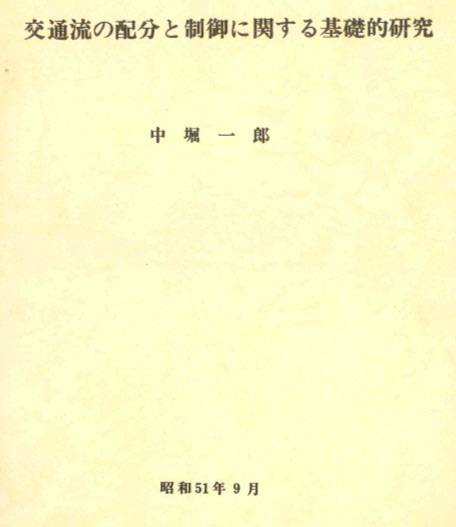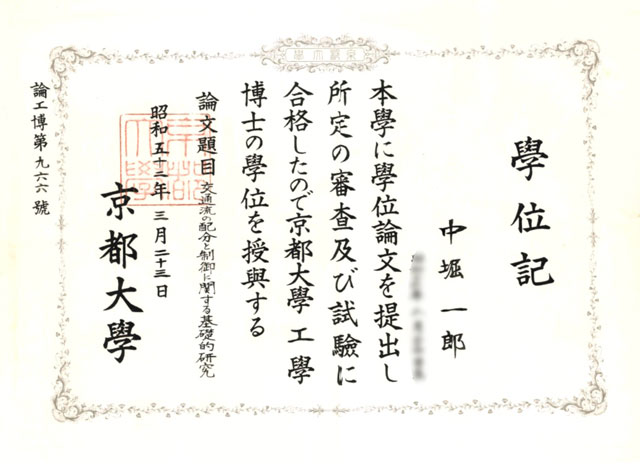
About one and a half years before joining the Enasan Tunnel Project, I received very kind advice from my superiors, Director B and Chief Researcher U, suggesting that I compile my research findings and pursue a doctoral degree.
However, I felt that my research skills were still insufficient at that time. Therefore, I expressed my desire to receive guidance from Professor Yoshikazu Nishikawa of the Department of Electrical Engineering at Kyoto University’s Faculty of Engineering, who had been my supervisor during my master’s program. They kindly approved my request.
With their approval, starting in April 1974, I was admitted to the working professional doctoral course in Professor Yoshikazu Nishikawa’s laboratory at the Department of Electrical Engineering, Kyoto University.
During this period, my schedule was quite demanding: from Monday to Thursday, I worked at the Central Research Institute in Itami, handling tasks related to the Enasan Tunnel Project and other responsibilities, and from Friday through the weekend, I received research guidance at Kyoto University.
On August 23, 1975, the Enasan Tunnel was officially opened. Freed from the large-scale project I had been intensively involved in for two years, my previously peaceful research life returned.
At the start of the Enasan Tunnel Project, I was the only researcher specializing in road traffic. However, by the time the project concluded, seven or eight young researchers had gathered in various fields of social infrastructure system research, including road tunnels, water supply and sewage, railways, and new transportation systems.
Under the guidance of Professor Yoshikazu Nishikawa, the research on traffic flow assignment had reached the stage of consolidating its results. I compiled my findings into two papers and submitted them to the Transactions of the Institute of Electronics, Information and Communication Engineers.
One of the papers, co-authored with Professor Nishikawa and titled “A New Algorithm for Finding Equilibrium Solutions to the Traffic Flow Assignment Problem,” was published in the March 1976 issue of the journal. Additionally, the paper on ventilation control applied to the Enasan Tunnel was nearly ready for submission to the Journal of the Japan Society of Civil Engineers.
Seeing this progress, Professor Nishikawa suggested that it was time to begin compiling my doctoral dissertation. I started working on the dissertation, structuring it around the following five themes, and began the process of developing the narrative for each theme.
- Fundamental Considerations on the Traffic Flow Assignment Problem
- Practical Aspects of Traffic Flow Assignment Algorithms
- Considerations on the Equilibrium Problem of Traffic Demand and Supply
- State Models and State Estimation of Road Traffic Flow
- Statistical Models and Forecasting of Road Traffic Flow

Asserting the originality of my work by comparing and contrasting it with the achievements of predecessors required a great deal of patience and energy.
My doctoral dissertation was completed in September 1976. I submitted it to Kyoto University and underwent an oral examination as well as language and other academic tests on the afternoon of February 3, 1977.
The oral examination was conducted by Professor Nishikawa, Professor Kijima, Professor Hattori, and Professor Okada from the Department of Electrical Engineering, as well as Professor Sasaki from the Department of Civil Engineering. Although I was very nervous about the English and German language tests, perhaps because they were familiar with my abilities, the questions were not particularly difficult.
On March 28, 1977, I was awarded my doctoral degree at Kyoto University. The person who was happiest about my achievement was my father, Takashi. He was an alumnus of Kyoto University’s Department of Electrical Engineering and had earned his own doctorate in 1956, so he was truly delighted that his son had also obtained a doctoral degree.
My wife, Junko, was glad as well, relieved that I had finally earned my doctorate and that our family life could return to normal.
Upon receiving my doctoral degree, I was presented with a watch by the Mitsubishi Electric Research Institute. My colleagues from the Enasan project gathered at the Mitsubishi Electric dormitory in Tokyo and held a celebratory party in my honor. Having set my goal to obtain a doctorate while working at the research institute, achieving it marked the end of my time at the Central Research Institute.
Sadly, my mentor, Professor Eiichi Nishikawa, passed away in 2021 during the COVID-19 pandemic. Along with fellow members of Nishikawa’s laboratory, I helped organize a memorial gathering held on October 19, 2024, at the Prince Hotel in Takaragaike, Kyoto. Together with Professor Nishikawa’s wife and two daughters, we were able to honor his memory.
The debt of gratitude I owe to Professor Nishikawa is something I will never forget.

References:[1] Ichiro Nakahori and Yoshikazu Nishikawa, “A New Algorithm for Finding Equilibrium Solutions to the Traffic Flow Assignment Problem,” Transactions of the Institute of Electronics, Information and Communication Engineers, Vol. J59-A, No. 3, pp. 192-199, March 1976.
[2] Ichiro Nakahori, Yoshikazu Nishikawa, and Katsuichi Nakazaki, “Graph-Theoretic Considerations and Algorithms for Multi-Commodity Flow Assignment Problems,” Transactions of the Institute of Electronics, Information and Communication Engineers, Vol. J60-A, No. 2, pp. 154-161, February 1977.
[3] Motoharu Ueki, Ichiro Nakahori, and Kazuo Maeda, “A New Ventilation Control Method for Long Roadway Tunnels,” Proceedings of the Japan Society of Civil Engineers, No. 265, September 1977, p. 83.
[4] Ichiro Nakahori, Fundamental Studies on Traffic Flow Assignment and Control, Doctoral Dissertation, Kyoto University, September 1976.
